31/01/2025 Market Watch

Markets Brace for Potential Tariffs
The US dollar is gaining strength as renewed concerns over a potential 25% tariff on Canada and Mexico weigh on market sentiment. Despite this, global equities remain firm, with major markets holding their ground. Investors and businesses remain on edge as uncertainty lingers over the potential policy changes.
In the currency markets, the US dollar is mixed against G10 currencies in Europe, fluctuating within a narrow range of +/- 0.25%. The Canadian dollar and Mexican peso have stabilized after weakening in the previous session. However, both currencies are under pressure for the week, with the Canadian dollar down about 1% and the Mexican peso declining by approximately 2.2%, making it the worst-performing emerging market currency.
Equity markets in the Asia-Pacific region mostly advanced, with Japan and Australia posting gains. In Europe, the Stoxx 600 is extending its rally, marking its fourth consecutive daily gain and its 11th advance in the past 13 sessions. US equity futures are also trading with a positive bias.
Bond yields are showing a mixed picture. European benchmark yields are slightly lower by 2-4 basis points, while UK Gilt yields remain flat. The US 10-year yield is marginally higher at 4.53%, unchanged from last week’s close.
Gold reached a record high of $2,811 before pulling back to consolidate near $2,793. Meanwhile, oil markets are closely watching developments regarding potential tariffs. There has been no official confirmation on whether Canadian and Mexican oil will be included in the proposed trade measures. WTI crude for March delivery is fluctuating between $72.40 and $73.50, staying within the previous session’s range. The 200-day moving average, which has held since late last year, sits slightly above $72. Any tariff on Canadian oil could put upward pressure on gasoline prices in the US.
United States of America
The US Dollar Index found support near 107.50 yesterday and has since climbed to a six-day high of 108.35, driven by renewed tariff threats. Resistance is seen near 108.60, and the recent rebound from Monday’s low of just under 107.00 has raised doubts about a potential topping pattern.
Market attention remains on President Trump's latest warning of a 25% tariff on Canadian and Mexican goods, which could take effect as early as tomorrow. Meanwhile, today’s economic data is unlikely to influence Federal Reserve policy, posing little more than headline risk. However, yesterday’s GDP report suggests upside risk to consumer spending.
Inflation indicators are well-anticipated, with economists expecting the headline PCE deflator to rise to 2.6% from 2.4%, while the core measure is likely to remain at 2.8%. Another key focus is the Q4 Employment Cost Index, a broader measure of labor costs than wages alone. While labor cost growth moderated last year, it remains elevated compared to pre-pandemic trends.
Key Points:
- The US Dollar Index has rebounded, challenging expectations of a topping pattern.
- Tariff concerns on Canadian and Mexican goods are supporting the dollar.
- Economic data is unlikely to impact Fed policy but suggests strength in consumer spending.
- Inflation indicators are in line with expectations, with core PCE steady at 2.8%.
- Labor costs remain elevated despite some moderation last year.
Australia
The Australian dollar extended its losing streak to four sessions yesterday, briefly falling below $0.6200 for the first time in eight days. While it is holding above this level today, a close below $0.6200 could signal a retest of the $0.6130 area, last seen in the middle of the month. Technical indicators suggest further downside momentum.
Economic data released today had little influence on market sentiment or expectations for the Reserve Bank of Australia’s policy outlook. The Q4 Producer Price Index (PPI) rose 0.8% quarter-over-quarter and 3.7% year-over-year, while December's private sector credit increased by 0.6%. These figures did not alter expectations that the RBA may begin its easing cycle as early as next month.
Key Points:
- The Australian dollar remains under pressure, testing key support levels.
- A close below $0.6200 could open the door for a decline toward $0.6130.
- Technical indicators suggest further downside momentum.
- Q4 PPI and private sector credit data had little impact on the currency.
- Markets still anticipate the RBA to begin easing in the coming months.
Canada
The US dollar surged against the Canadian dollar following President Trump’s reaffirmation of a 25% tariff threat on Canada. The greenback spiked from around CAD1.4415 to nearly CAD1.46 in minutes during the North American session but has since settled into a range between CAD1.4430 and CAD1.4510.
Despite reports indicating that only a small percentage of illegal border crossings occur on the northern border and that Canada accounts for just 0.2% of fentanyl confiscations, the US threat appears disproportionate. This situation mirrors concerns over BRICS, where speculation about a potential rival to the US dollar lacks concrete evidence.
Market volatility remains elevated, with three-month implied volatility at 7.3%-7.5%, well above its 100- and 200-day moving averages of 5.7% and 5.4%, respectively. The current sideways movement in USD/CAD could form either a base or a top, but with momentum indicators turning higher and the US-Canada two-year yield spread widening, an upside breakout for the US dollar appears likely.
Canada is set to report a 0.1% contraction in GDP for November after a 0.3% expansion in October, adding further pressure on the Canadian dollar.
Key Points:
- The US dollar spiked to nearly CAD1.46 after renewed tariff threats.
- USD/CAD is trading within a firm range of CAD1.4430-CAD1.4510.
- The US threat appears disproportionate given limited border and drug-related concerns.
- Market volatility is elevated, supporting the potential for an upside breakout.
- Canada’s GDP is expected to show a slight contraction, adding pressure to the loonie.
China
With China's onshore markets closed until February 5, the offshore yuan remains in consolidation mode. The US dollar had been trading within last Friday’s range (CNH7.2345-CNH7.2880) but has now climbed above CNH7.30 for the first time since President Trump’s inauguration in 2017, supported by broader dollar strength.
Despite the ongoing holiday, the Caixin January PMI is set for release early Monday, though only a minor uptick is expected. The more significant development this week has been China’s unveiling of Deep Seek and other advanced semiconductor initiatives, seen as a direct challenge to US dominance in chip technology. These efforts signal China’s determination to counter US containment strategies in the sector. Estimates suggest that China produces ten times more engineering bachelor’s degrees than the US, further strengthening its long-term position in high-tech industries.
Key Points:
- The offshore yuan remains in consolidation as onshore markets stay closed until February 5.
- The US dollar has broken above CNH7.30 for the first time since 2017.
- The upcoming Caixin January PMI is expected to show only a slight increase.
- China’s Deep Seek initiative aims to challenge US dominance in semiconductor technology.
- China produces significantly more engineering graduates than the US, reinforcing its push in advanced industries.
Europe
The euro continues to weaken, marking its fifth consecutive session of declines. A brief short squeeze, triggered by ECB President Lagarde’s reluctance to pre-commit to policy changes while acknowledging uncertainty—similar to Fed Chair Powell’s stance—fizzled out near $1.0470. However, Trump’s tariff comments pushed the euro lower, falling to $1.0385 yesterday and testing $1.0365 today, aligning with the 20-day moving average.
The swaps market has grown more confident in at least two quarter-point ECB rate cuts in the first half of the year, a stronger expectation than before the recent ECB meeting. Lagarde’s data-dependent stance puts Monday’s preliminary CPI release in focus. Early reports from German states suggest a slight monthly decline, likely keeping the annual inflation rate steady at 2.8%. France’s harmonized CPI dropped by 0.2% month-over-month but remained unchanged at 1.8% annually. Meanwhile, Spain reported a 0.1% decline, though its annual rate edged up to 2.9% from 2.8%, with core inflation easing to 2.4% from 2.6%.
Key Points:
- The euro is on its fifth consecutive session of losses.
- A brief rally faded after Trump’s tariff remarks, pushing the euro to new lows.
- Markets now expect at least two ECB rate cuts in the first half of the year.
- Germany’s inflation data suggests stability, while France and Spain show mixed trends.
- Monday’s preliminary CPI release will be crucial in shaping rate expectations.
Japan
The US 10-year yield fell to a new monthly low of 4.48% yesterday, pushing the greenback to its lowest settlement against the yen since mid-December. The dollar briefly dipped to JPY153.70, testing the month's low, but a broader dollar recovery and slight uptick in US yields saw it rebound to nearly JPY155 today.
The Bank of Japan (BOJ) continues to signal a tightening bias. Deputy Governor of the BOJ reaffirmed the intention to raise rates, assuming the economy performs as expected. Additionally, the BOJ plans to phase out a fund-provisioning program, which will reduce its balance sheet by approximately 15% over the next few years, removing JPY77 trillion (~$500 billion) from its JPY740 trillion portfolio. The BOJ’s purchases of commercial paper and corporate bonds are also set to end this month.
Japan’s economic data was mixed. Retail sales in December fell by 0.7%, a larger-than-expected decline following November’s 1.9% increase. Industrial output stabilized with a 0.3% gain after a sharp 2.2% drop in November. Unemployment eased unexpectedly to 2.4%, down from 2.5%. The Tokyo CPI, a leading indicator for national inflation, rose to 3.4%, up from 3.1%, with the core measure ticking up to 2.5% from 2.4%. The measure excluding fresh food and energy edged up to 1.9% from 1.8%.
Key Points:
- The US dollar dipped to a new monthly low but rebounded to nearly JPY155 today.
- The BOJ’s tightening plans are gaining momentum, with expected balance sheet reductions.
- Japan’s retail sales, industrial output, and unemployment data showed mixed results.
- Tokyo CPI inflation accelerated to 3.4%, indicating rising price pressures.
- The BOJ’s actions signal continued policy adjustments in the face of economic challenges.
United Kingdom
The British pound remains resilient, pulling back by about 1.25 cents from Monday’s high but finding support just below $1.24 in the middle of the week. The currency then rose to nearly $1.2480 yesterday and is currently consolidating in a narrow $1.2400-$1.2440 range.
The recent upside correction, following a dip to $1.21 in mid-January, does not appear to be fully complete. A break above $1.2540 could signal a move toward $1.26, where the correction may find its limit. Attention now turns to next week’s Bank of England meeting, where a quarter-point rate cut is anticipated, with another possible cut expected by the end of Q2.
The mini-Gilt sell-off earlier this month appears to be over, as the 10-year UK Gilt yield dropped to 4.52%, matching the monthly low after peaking at 4.92% on January 9.
Key Points:
- The British pound is consolidating between $1.2400 and $1.2440 after a recent pullback.
- A push above $1.2540 could lead to further gains toward $1.26.
- The Bank of England is expected to cut rates by 0.25% next week and another by Q2.
- The mini-Gilt sell-off has subsided, with the 10-year yield falling to 4.52%.
- The outlook for Sterling remains dependent on upcoming Bank of England actions.
© 2025 SKONE Enterprise (003319453-V). All rights reserved.
The content on this site is for informational purposes only and does not constitute financial advice.


